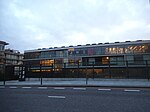Shir Hayim
1975 establishments in England2020 disestablishments in EnglandBuildings and structures in the London Borough of CamdenJewish organizations established in 1975Reform synagogues in the United Kingdom ... and 3 more
Religion in the London Borough of CamdenSynagogues in LondonUse British English from October 2019

Shir Hayim ("A Song of Life") was a Reform Jewish synagogue and congregation at Hashomer House, Broadhurst Gardens, West Hampstead in the London Borough of Camden. It was established in 1975 and until 1988 was known as Hampstead Reform Jewish Community. Services were held on Friday evenings and Saturday mornings. In 2020 it merged with Willesden Minyan to form a new Reform Judaism congregation, Makor Hayim.
Excerpt from the Wikipedia article Shir Hayim (License: CC BY-SA 3.0, Authors, Images).Shir Hayim
Broadhurst Gardens, London South Hampstead (London Borough of Camden)
Geographical coordinates (GPS) Address Nearby Places Show on map
Geographical coordinates (GPS)
| Latitude | Longitude |
|---|---|
| N 51.5466 ° | E -0.1857 ° |
Address
Broadhurst Gardens 99d
NW6 3BP London, South Hampstead (London Borough of Camden)
England, United Kingdom
Open on Google Maps









